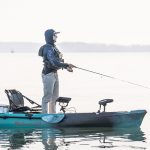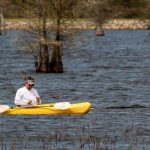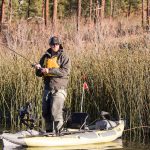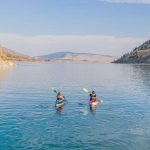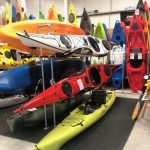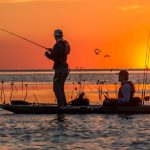Since kayak fishing has exploded in popularity, brands have developed models that let anglers stand up and fish. Here's our top list of those.

Kayaks are incredibly varied in size—from tiny, kid-friendly 6-footers to great big 16-footers long enough to cross hundreds of miles of open water.
But the most versatile size, by far, is the standard 10-foot kayak.
A 10-foot kayak is the perfect length to give you good speed, tracking, handling, stability, maneuverability, and storage space, all without being overly heavy or cumbersome.
For the average recreational kayaker or angler, it’s the perfect choice!
Below, we’ve assembled a list of the best 10-foot kayaks, along with a complete buying guide to help you know exactly what to look for in the ideal fishing or recreational kayak.
By the end of this post, you’ll be ready to choose the exact right kayak for your specific needs, preferences, and intended activity.
As an affiliate of Amazon and other retailers, we may earn a small commission when you buy via our links, at no additional cost to you. Thank you!
Quick Answer: Best 10 ft Kayaks
Best Sit-Inside: Wilderness Systems Pungo 105
Best Budget Sit-Inside: Pelican Maxim 100X
Best Budget Sit-on-Top: Pelican Sentinel 100X
Best 10 ft Fishing Kayak: FeelFree Moken 10 V2
Best 10 ft Pedal Kayak: Hobie Mirage Passport 10.5
Best Tandem: Lifetime Kokanee 106
Best Inflatable: Advanced Elements AdvancedFrame
Best Premium: Eddyline Sky 10
Comparison Table: Best 10 ft Kayaks
| Model | Specs | Where to Buy |
Wilderness Systems Pungo 105 | Weight: 47 lbs. Weight Capacity: 300 lbs. Design: Sit-inside | Amazon |
Pelican Maxim 100X | Weight: 39 lbs. Weight Capacity: 275 lbs. Design: Sit-inside | Amazon |
Pelican Sentinel 100X | Weight: 42 lbs. Weight Capacity: 275 lbs. Design: Sit–on-top | Amazon |
FeelFree Moken 10 V2 | Weight: 65 lbs. Weight Capacity: 440 lbs. Design: Sit–on-top | Eco Fishing Shop |
Hobie Mirage Passport 10.5 | Weight: 65 lbs. Weight Capacity: 325 lbs. Design: Sit–on-top | Eco Fishing Shop |
Lifetime Kokanee 106 | Weight: 77 lbs. Weight Capacity: 425 lbs. Design: Sit–on-top | Amazon |
Advanced Elements AdvancedFrame | Weight: 36 lbs. Weight Capacity: 300 lbs. Design: Sit–inside | Amazon |
Eddyline Sky 10 | Weight: 32 lbs. Weight Capacity: 250 lbs. Design: Sit–inside | REI |
Best 10 ft Kayaks Reviewed
Best Sit-Inside: Wilderness Systems Pungo 105

Weight: 47 lbs. (21.3 kg)
Weight Capacity: 300 lbs. (136 kg)
Design: Sit-inside
Speed, stability, comfort, and top-tier performance: that’s what the Wilderness Systems Pungo 105 offers in spades. The Pungo hull is tough enough to withstand anything short of whitewater use, so you can take it into coastal waters, navigate canyon rivers, or zip around lakes fully confident the kayak will keep up with you. It’s also sleek and speedy, giving you excellent tracking and handling so you’re always in control of your progress.
This sleek, maneuverable kayak is feature-rich: incredibly comfortable patented Phase 3® AirPro seating system, SlideTrax ™ to accommodate fishing rod and phone mounts, removable DryTec dry box, two cup holders, a slot for the Wilderness Systems Lithium Battery and a motor mount, a protective skid plate, and a rear storage hatch. The kayak’s hull is designed for reassuring stability but does not sacrifice performance.
It’s an upper-tier 10-foot kayak that will serve you well for years to come.
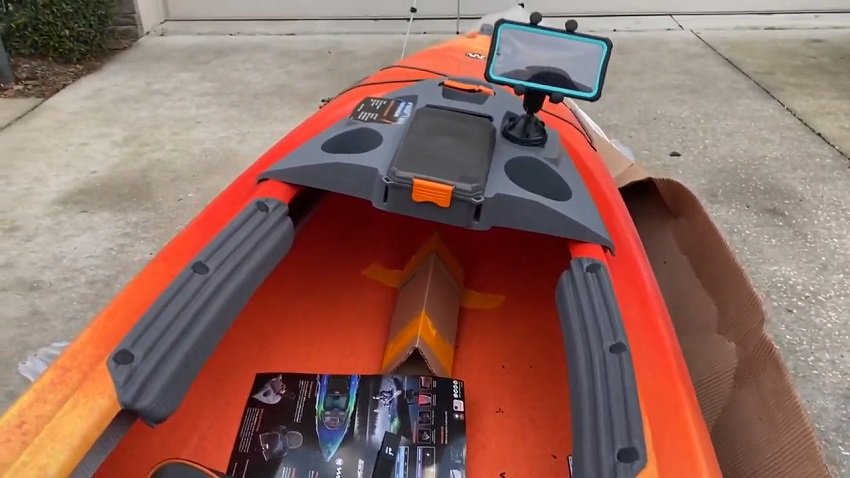
Pros:
- Built tough
- Excellent handling and tracking
- Speedy and sleek
- Excellent weight capacity
Cons:
- On the heavier side for a recreational kayak
Best Budget Sit-Inside: Pelican Maxim 100X

Weight: 39 lbs. (17.7 kg)
Weight Capacity: 275 lbs. (124.7 kg)
Design: Sit-inside
Keep it simple and cheap with this Pelican kayak, one of the most affordable kayaks on the market.
The Maxim 100 is a very basic 10-foot kayak, with the standard rotomolded plastic seat with minimal cushioning and just enough lumbar support to keep you comfortable for a few hours of paddling.
It also features an integrated drink holder right in front of you so you can keep your can close at hand over a long day out on the water. Though it doesn’t include dry storage, there is a rear tankwell with a protective netting system to keep your dry bag or cooler box securely in place.
Despite being a budget-friendly kayak, it’s insanely tough (pretty much bomb-proof, I’ve found through years of regular use) thanks to the thick polyethylene hull. Handling and tracking are decent (especially if you install your own skeg), though you won’t be winning any races. Still, it’s the perfect recreational kayak for any newbie paddlers who aren’t looking to break the bank on their first purchase.
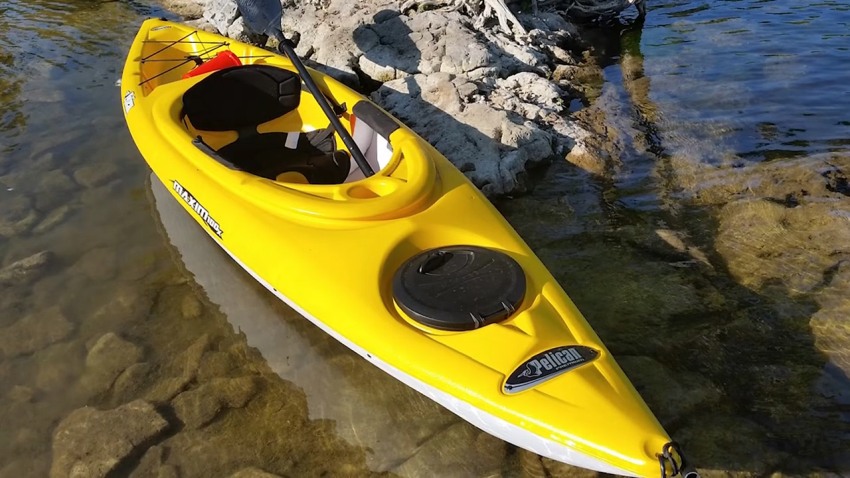
Pros:
- Incredibly affordable
- Sturdy; resistant to abrasions, scuffs, and impacts
- Good primary stability on calm water
- Great for beginner paddlers
Cons:
- Slower-moving; tracking could be better
- Not the most comfortable for multi-day use
Best Budget Sit-on-Top: Pelican Sentinel 100X

Weight: 42 lbs. (19 kg)
Weight Capacity: 275 lbs. (124.7 kg)
Design: Sit–on-top
For those who just want to get out on the water and don’t much care about what they’re paddling to do it, this is a great affordable kayak to consider. The sit-on-top design makes it very stable for recreational use, and you’ll find that it’s not too bad for catching smaller fish, either. Though not the most advanced sit-on-top kayak, it’s very wallet-friendly and designed to help beginners get comfortable in an open cockpit.
Features of this kayak include: a 13L removable storage compartment, front storage platform sized for a cooler or tacklebox, molded footrests, a bottle holder, two paddle tie-downs, anti-slip carpet so you can stand comfortably, ERGOLOUNGE seating system with decent cushioning in the seat and backrest, and scupper holes to allow water to drain out. There’s also an angler version of this kayak with some fishing-specific features such as flush-mounted rod holders.
Thanks to the twin-arched multi-chine flat hull, you’ve got excellent primary stability and enough secondary stability that you can comfortably navigate even when the river is flowing faster or the lake gets choppy.
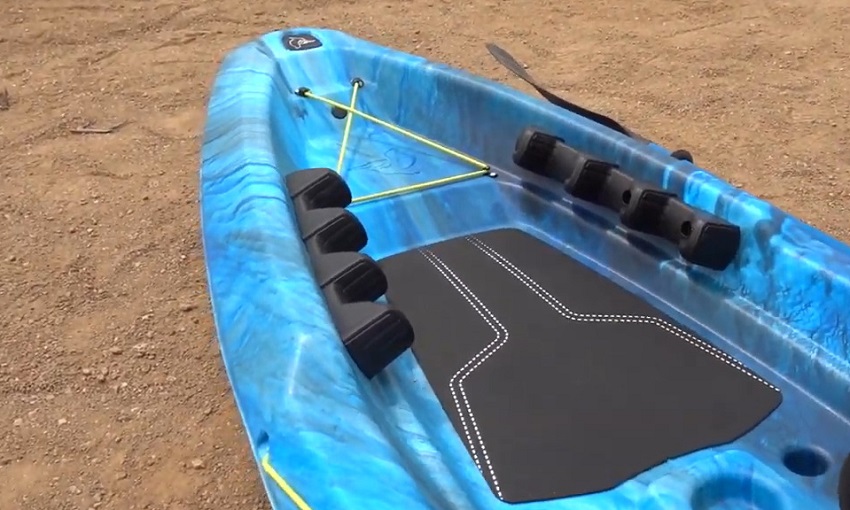
Pros:
- Excellent stability
- Surprisingly comfortable for a budget-friendly model
- Good weight capacity
- Incredibly durable hull (high molecular density polyethylene)
Cons:
- Not very fast or agile
- Limited dry storage space
Best 10 ft Fishing Kayak: FeelFree Moken 10 V2

Weight: 65 lbs. (29.5 kg)
Weight Capacity: 440 lbs. (199.6 kg)
Design: Sit–on-top
One of the best 10-foot fishing kayaks on the market, you’re going to love the FeelFree Moken 10 V2. This 10-foot sit on top kayak is built with kayak fishing in mind, offering everything you’ll need for a perfect day out on the water.
The Moken has an ultra-comfy EZ Rider Multi-Position + Height Adjustable Seat, Uni-Track accessory rails for your rod holders or electronics, and a built-in paddle holder. There’s also an over-sized tankwell for your cooler and/or fishing tackle and a spacious open cockpit with adjustable foot braces. Last but not least, this kayak is compatible with FeelFree’s Beaver Tail Rudder system.
The Moken is a little on the heavy side for a 10 ft fishing kayak, but it comes with a “Wheel in the Keel” that makes transporting it solo a whole lot easier. Though it’s a 10-footer, it feels like a much bigger kayak, with plenty of room to move, shift, and stretch out. Its primary stability is excellent but it can hold its own on choppy water, too. The kayak’s weight capacity is 440 pounds, so it’s definitely a 10-footer that bigger, heavier paddlers can love.
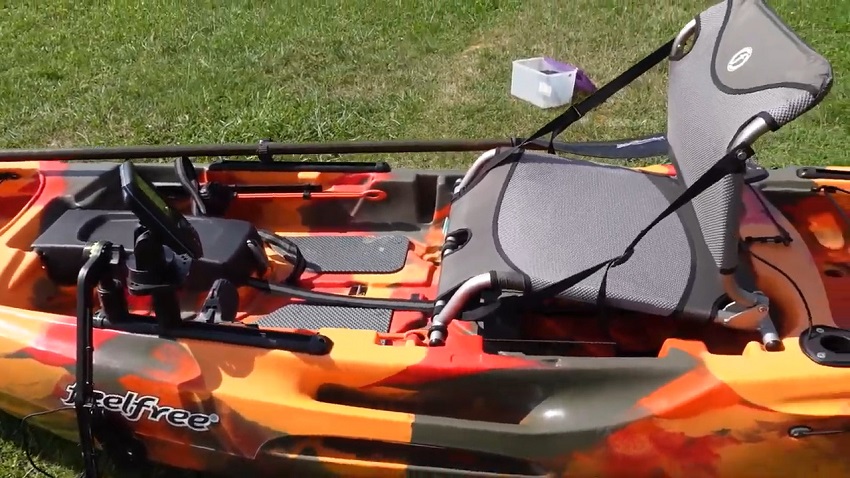
Pros:
- Roomy and spacious sit-on-top design
- Industry-leading weight capacity
- Feature-rich, packed with accessories
- Built for the serious angler
Cons:
- A bit on the heavy side
- Not ready for a fish finder (unlike Moken 12.5)
Best 10 ft Pedal Kayak: Hobie Mirage Passport 10.5

Weight: 65 lbs. (29.5 kg)
Weight Capacity: 325 lbs. (147.4 kg)
Design: Sit–on-top
For hands-free fishing, pedal kayaks will be your best friend—and you won’t find a better pedal drive model than the Hobie Mirage Passport 10.5. This 10-foot kayak is sleek, sturdy, beautifully responsive to your paddling, and surprisingly fast for a fishing kayak. Thanks to the integrated pedal drive, you can keep moving forward even while casting out or reeling in a line, futzing with your tackle box, or cracking open a cold one.
MirageDrive with Glide Technology features special roller bearings at “friction points” in the entire system, giving you a smoother, more efficient ride and reducing the amount of effort required to paddle. Thanks to the Kick-Up Fins, you can slice through shallow water or over obstacles close to the surface trusting that your propulsion and steering system will remain undamaged.
The suspended mesh aluminum frame seat is comfortable for a long day of reclining, and you’ll find there’s leg room enough to stretch out long legs. The bow and stern cargo areas give you enough storage space for all your gear, and the kayak comes with both accessory mounting tracks and two fishing rod holders. Though on the heavier side, it’s a tough, ultra-reliable kayak that will serve you well for years of happy angling to come.
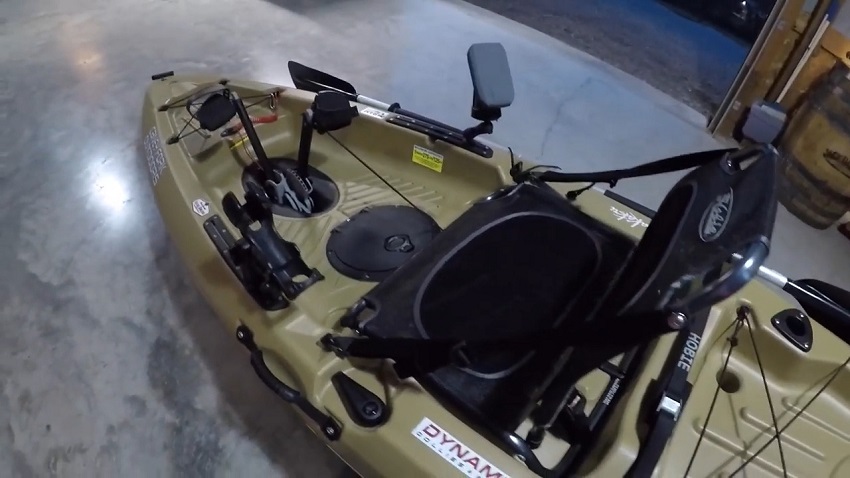
Pros:
- Pedal drive system makes for easy hands-free propulsion
- Ultra-sturdy construction
- Speedy and responsive
- Feature-rich; built specifically for kayak anglers
- Comfortable and roomy
Cons:
- Very heavy—may take two people to portage
- On the pricier side
Best Tandem: Lifetime Kokanee 106

Weight: 77 lbs. (34.9 kg)
Weight Capacity: 425 lbs. (192.7 kg)
Design: Sit–on-top
A 10-foot tandem kayak? Who knew?! Most tandem kayaks are 12+ feet long, which makes the 10.5-foot Lifetime Kokanee 106 unique in its class. It’s sleek, compact, and far more responsive than a full-sized tandem kayak, but still has space for two people. Granted, those will be “average-sized” people—anyone taller than 6’ may find the open cockpit a bit cramped—but you can still fit two children, teenagers, or smaller adults on one kayak in style.
The 425-pound weight capacity definitely is up for handling two paddlers, and it will take two people to haul the 77-pound tandem kayak to and from the water. However, once you’re out and paddling, you’ll love how well it handles and tracks, with surprisingly good speed for a sit-on-top kayak.
The HDPE hull is able to withstand impact and abrasions, and nothing short of a nuclear detonation will damage this bad boy. The material is even UV-resistant so it won’t deteriorate with regular exposure to sunlight.
Best of all, the design is versatile enough you can use it for both solo and tandem paddling. Now that’s bang for your buck!
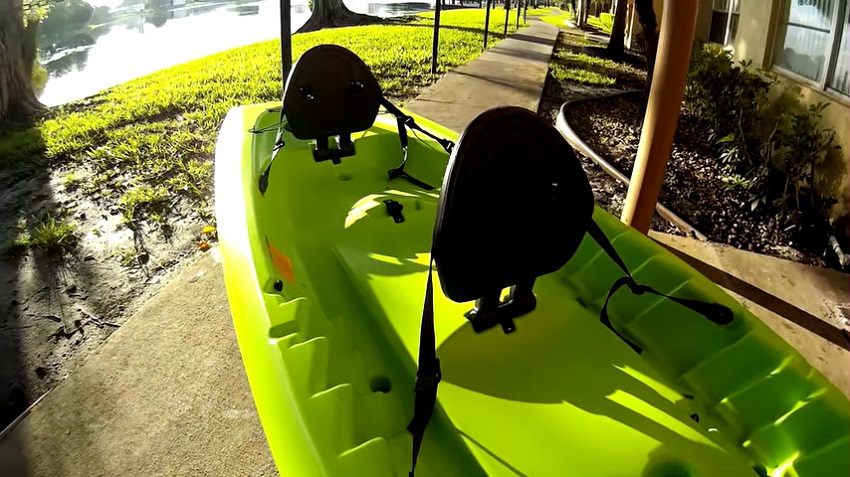
Pros:
- Can be used as a solo kayak or tandem
- Decent storage space—hatches give you access to under-deck compartments
- Good weight capacity
- Responsive, handles well
Cons:
- Very heavy
- Not the most spacious when in tandem configuration
Best Inflatable: Advanced Elements AdvancedFrame

Weight: 36 lbs. (16.3 kg)
Weight Capacity: 300 lbs. (136 kg)
Design: Sit–inside
This list would not be complete without some inflatable kayaks, so here you go. The Advanced Elements AdvacedFrame is a 10 ft inflatable sit-inside kayak, but it handles and tracks more like a hard-shell kayak, thanks to the rigid aluminum bow and stern frame reinforcement.
In fact, you’ll find it’s a lot speedier and tracks straighter than many of the budget-friendly kayaks around—some users have compared its performance to a day touring kayak.
The multi-chamber inflatable body gives it extra durability, so that even in the (highly unlikely) event the PVC-coated polyester is damaged, the kayak will remain afloat long enough to get you back to shore. The Twistlok and Spring valves work with most hand, foot, and electric-powered pumps so you can inflate and deflate the kayak with ease.
Because it’s inflatable, it’s both beautifully portable and fairly lightweight. Pack it down small, throw it in the trunk of your car, and you can pull it out when car camping, road-tripping, or exploring backcountry trails. Though it’s pricier than some entry-level inflatable kayaks (such as the uber-popular Intext or Sevylor models), it’s worth every penny thanks to its superior tracking, handling, and durability.
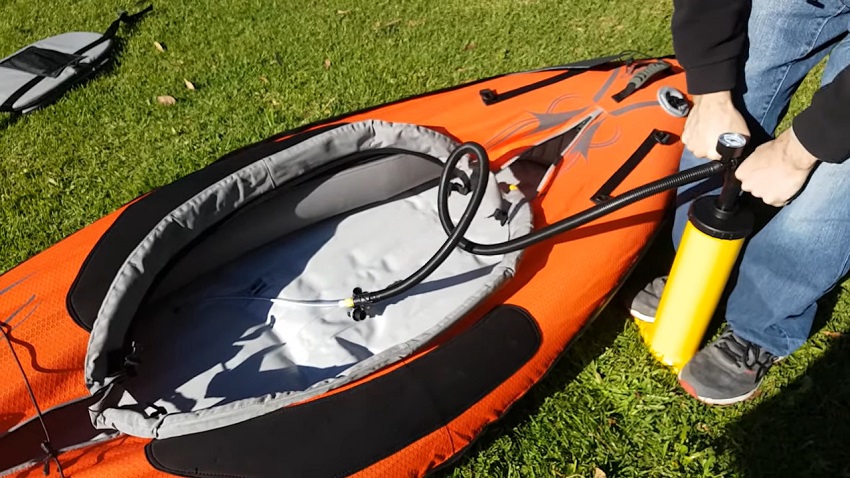
Pros:
- Portable and lightweight
- Sturdy, reliable aluminum frame with PVC-coated polyurethane shell
- Handles and tracks more like a hard-shell kayak
- Affordable price tag, but very durable
- Good on-board storage space without sacrificing leg-room
Cons:
- Paddle not included
- Not as durable as a hard-shell kayak
Best Premium: Eddyline Sky 10

Weight: 32 lbs. (14.5 kg)
Weight Capacity: 250 lbs. (113.4 kg)
Design: Sit–inside
For recreational paddlers who want only the best, the Eddyline Sky 10 is a premium-quality sit-inside kayak that will deliver everything you want: speed, stability, agility, and arrow-straight tracking. It’s also built insanely tough, using a Carbonlite composite ABS construction that will withstand any bumps or scrapes with ease and look good doing it.
The thermoformed hull is UV- and abrasion-resistant, but the composite laminate is far easier (and cheaper) to repair than lower-priced PE plastic. It’s also noticeably lighter than other 10-ft kayaks, making it perfect for quick trips to your local lake.
The cockpit is fairly spacious for a sit-inside 10-foot kayak, with a wide aperture that will fit all but the largest legs. Once inside, you’ll find the soft foam seat is beautifully comfortable and the padded backrest offers decent lumbar support. There are also adjustable foot braces to ensure an optimal paddling position.
The dual storage hatches offer enough space (including a watertight compartment) for all your gear, and the bungee deck rigging gives you extra space to secure a dry bag or cooler.
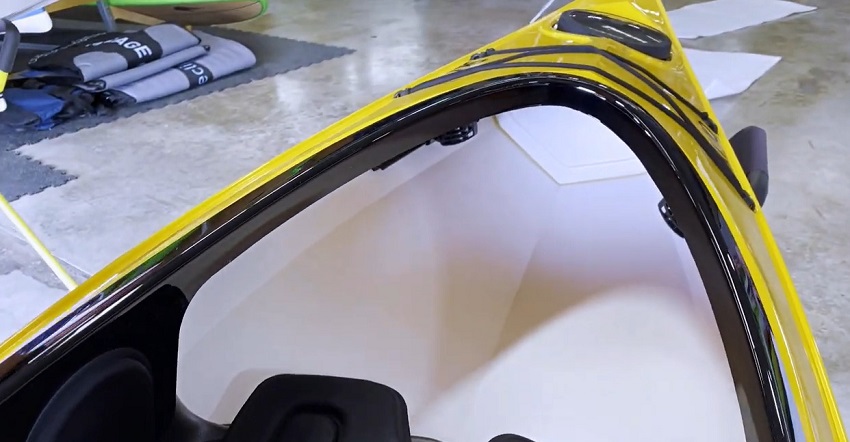
Pros:
- Lightweight
- Tracks amazingly well
- Good primary and secondary stability
- Built incredibly tough
- Speedy
Cons:
- May feel cramped for larger users
Why 10-Foot Kayaks?
Kayaks are built in different lengths for different purposes.
Short, speedy kayaks (8-footers) are built for navigating whitewater, when you need to make hairpin turns and surf fast-moving river currents.
Long, sleek kayaks (12- to 16-footers) are built for speed and stability, enabling you to cover long distances across open waters and choppy oceans.
The “standard-sized” 10-footers, though, are built for your “average” use.
Typically, they’re fast enough you can cover decent distance, but they’re light and compact enough to maneuver on rivers or off the ocean. They won’t be zippy enough to handle whitewater, and they’re definitely not sized for long-haul travel across the Great Lakes or multi-day ocean voyages. However, they’re perfect for paddling leisurely around a lake, down a slow-moving river, or enjoying a few good hours of kayak fishing.
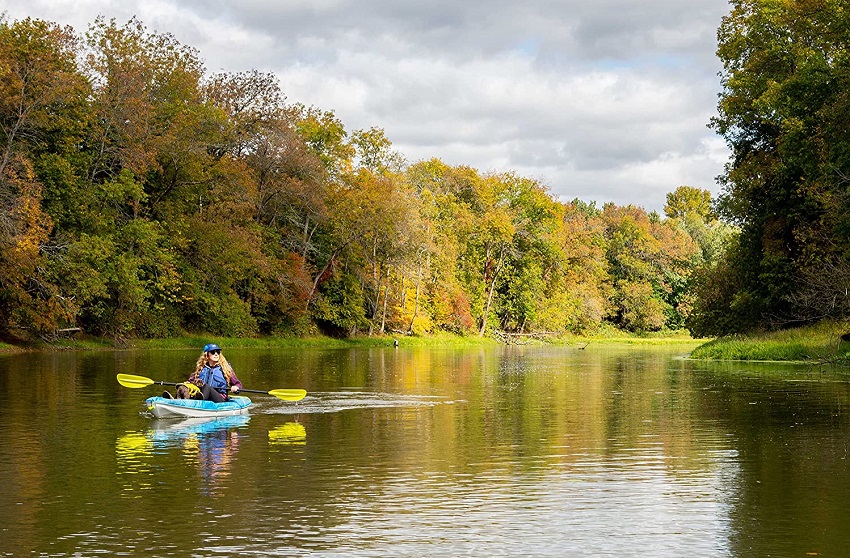
The majority of 10-foot kayaks are built for fishing or recreation. They have space enough for all your paddling essentials, offer good comfort features, and provide you with a ride that is both stable and maneuverable.
They’re not the most advanced kayaks, but they’re the “workhorses” of the kayak world that get the job done well.
Best of all, they’re typically the most budget-friendly options, too.
Don’t get me wrong: there are premium-quality 10-footers that retail for a high price.
But compared to the ultra-tough whitewater kayaks and the high-tech and uber-lightweight sea touring kayaks, 10-footers tend to be a much more affordable option overall.
10 ft Kayak Buying Guide: Factors to Consider
If you’re shopping for a good 10-foot kayak, here are the things that you should take into account:
Intended Use
As I mentioned above, 10-foot kayaks tend to fall into one of two categories: fishing or recreational.
Fishing Kayaks
10-foot fishing kayaks tend to feature an open, sit-on-top design, and are usually a bit wider, significantly heavier, and will have much higher primary stability (on calm water) so you have a balanced platform from which to wrestle with your fish.
Many will have fishing-specific accessories (see the “Accessories and Extras” section), a seat designed specifically for long hours of sitting comfortably trailing your line in the water, and ample storage space for coolers and tackle boxes.
Recreational Kayaks
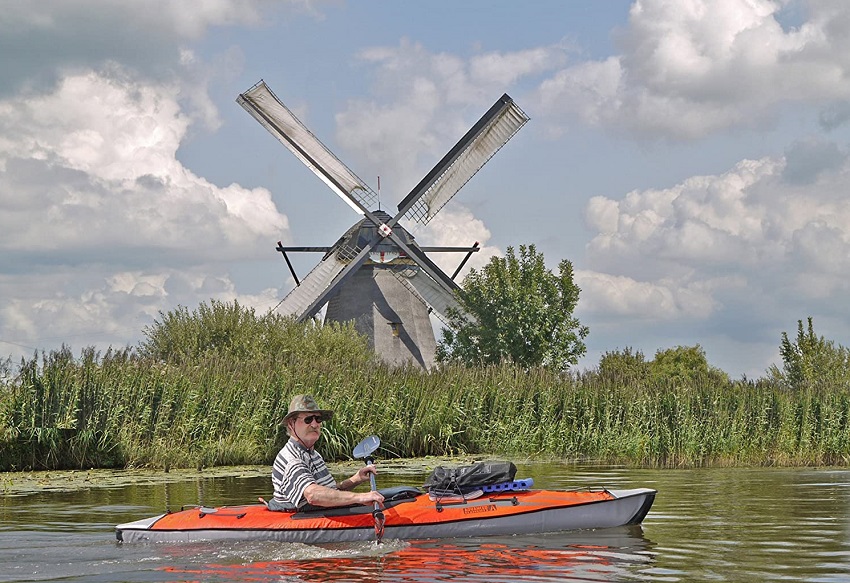
These kayaks tend to feature an enclosed, sit-inside design, and tend to be a bit slimmer, sleeker, lighter-weight, and may feature better secondary stability (particularly if they’re designed for coastal use).
They will be built more for speed and maneuverability than fishing kayaks, and will be compatible with spray skirts so you can use them even when the weather is cold, wet, and windy.
They may not come loaded with a lot of accessories (just the basic storage compartments), but they’re built more for paddling longer distances, exploring rivers, lakes, inlets, and coastal waters.
The two designs are very different—from the shape of the hull to the way they handle—so it’s important to consider what you plan to do with your 10-foot kayak in order to choose the one that suits your needs best.
Stability
We all want a stable kayak. But are two types of stability to consider:
1) Primary stability, or the stability when on flat water.
2) Secondary stability, or the kayak’s ability to remain stable when tipped onto its side.
The stability characteristics are defined by the kayak’s hull design.
When paddling a slow-moving river or a calm lake, primary stability is definitely the more important factor to consider. A kayak with high primary stability will often have a wide, flat hull design. It will stay balanced even if you stand up or shift your weight around a lot.
Secondary stability, however, comes into play if you’re paddling choppy waters—such as a faster-flowing river, a lake turned choppy by heavy winds, or off the ocean coast. The kayak may feel a bit more “tippy” when the water is calm, but you’ll have better stability when paddling over waves, swells in the lake caused by boaters, or currents in the river.
The majority of fishing kayaks prioritize primary stability above secondary stability, offering a very stable hull design for you to fish (either sitting down or standing up).
Recreational kayaks, on the other hand, may try to find a “middle ground” between good primary and secondary stability (depending on the model, design, hull shape, and intended use).
Consider the waters where you plan on doing most of your paddling (coastal, flat lakes, rivers, etc.) as well as what conditions to expect (calm, choppy, fast currents, etc.) and choose a kayak accordingly.
Weight Capacity
Every kayak has a limit of the amount of weight it can carry before it begins to sink.
Sit-inside kayaks will have a lower maximum weight capacity, because by their design, they naturally ride lower in the water. Too much weight (paddler + gear) will submerge the kayak enough that water can slop in over the sides, filling the kayak and increasing your risk of capsizing.
Sit-on-top kayaks, however, tend to have a higher maximum weight capacity because they’re basically hollow plastic shells filled with air. They ride higher on the water and have greater buoyancy. There’s also no cockpit that can get filled with water, so there’s a lower risk of capsizing on that score. However, if you exceed the load capacity, you’re loading the kayak with more weight than it’s rated to handle, and that will manifest in the form of instability and a higher risk of tipping over.
For smaller-sized, lighter-weight paddlers, load capacity isn’t a huge factor to consider. However, for bigger people (like myself, at 6’6” and 250 lbs.), it’s a very important element to evaluate.
Storage Capacity
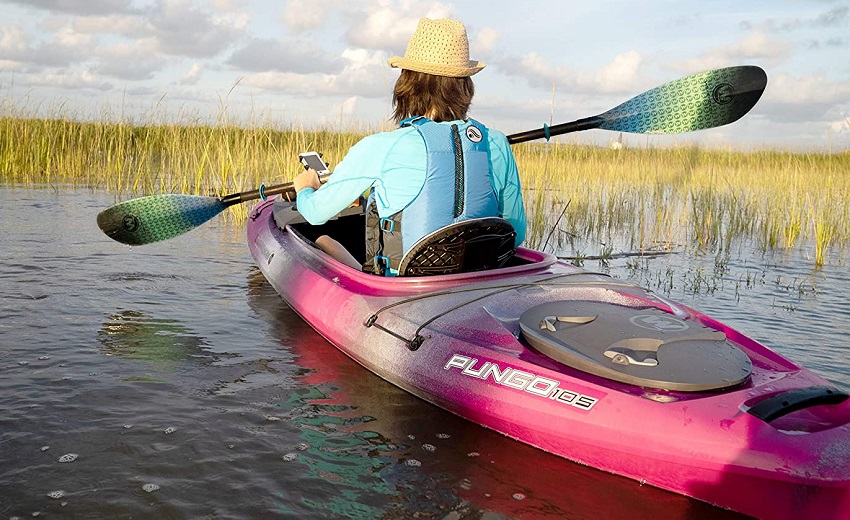
The longer you spend out on the water, the more gear and supplies you’ll need to take.
- For a few hours of paddling, you can get away with a bottle of water and a dry bag with a few essentials (dry clothes, maybe a snack, etc.).
- For a full day of kayak fishing, you’ll need more water, enough food to keep your energy levels up, plus a cooler to store the fish you catch and the tackle boxes with all your gear.
- For an overnight trip or kayak camping, you’ll need space to store your tent, sleeping bag, cooking gear, and other supplies.
- For a multi-day long-haul trip, you’ll need food, water, clothing, and other equipment to keep you going.
Given that most 10-foot kayaks are either fishing or recreational vessels, it’s unlikely that you’ll be spending multiple days out on the open water, so you won’t need a ton of supplies.
But you’ll still want to make sure your kayak has enough space to store the essentials that will keep you going when paddling for a few hours, a full day, or on an overnight camping trip.
Sit-inside kayaks can have one or two watertight storage compartments, or bulkheads. These are great not only for dry gear storage but also for safety as they make a kayak unsinkable.
Sit-on-top kayaks can have both in-hull storage and space to lash gear to your open deck. You’ll have to take precautions to protect it from the water.
Tracking and Handling
The shorter a kayak is, the easier it can make tight, sharp turns. Longer kayaks are slower to turn but tend to track straighter and stay on course more efficiently.
10 feet seems to be the sweet spot for recreational kayak length. Ten-foot kayaks are agile enough to maneuver, but they still track fairly well, making it easier to paddle in a straight line.
For fishing, you don’t really need to worry about a kayak’s handling or tracking; after all, you’re going to spend much of your time drifting along or moving under pedal power, following the current and the fish.
For recreational kayaking, however, you will want a kayak that can track fairly straight and handle well. That way, you can cover good distance across big lakes, but still have the agility to navigate faster-moving rivers, narrow inlets, or creeks.
Weight
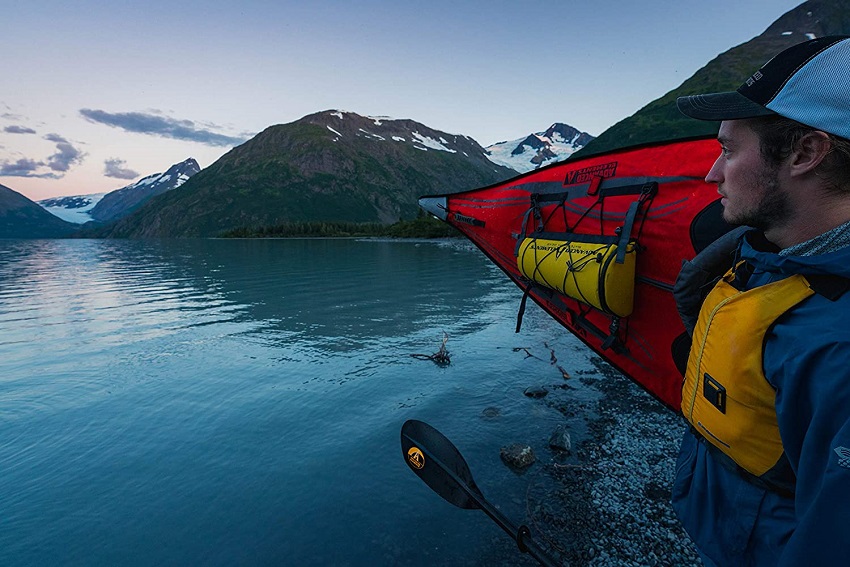
The beauty of a 10-foot kayak is that it’s portable enough that just one person should be able to carry it.
And no, I’m not talking about a big person like myself—even smaller people (like my 5’3” wife or 5’8” son) can handle the lighter-weight, shorter kayaks without too much difficulty.
It’s important to note that 10-foot fishing kayaks could be a good 25% or so heavier than recreational kayaks. It’s not a hard-and-fast rule, but typically fishing kayaks tend to be wider and slightly longer, and will likely use more material in the construction.
It’s definitely worth looking at the kayak’s weight to make sure it’s a load you can handle. A lighter kayak is easier to load and unload from your vehicle, carry to and from the water, maneuver in your garage, etc.
Comfort and Fit
Comfort and fit go together like strawberries and cream, or peanut butter and chocolate.
Fit
The “fit” of a kayak refers to how comfortable you, the paddler, are when sitting inside or on top of it.
- The seat should accommodate your butt and upper legs properly.
- The cockpit of a sit-inside kayak or the deck of a sit-on-top kayak should accommodate the length of your legs.
- You should feel stable enough to shift and move around as needed.
- You should be able to mount and dismount easily without feeling confined or enclosed (in a sit-inside cockpit).
- Your knees should have space to brace against the sides and/or inside of the sit-in cockpit, without feeling cramped.
A well-fitting kayak will make for a much more comfortable ride.
Comfort
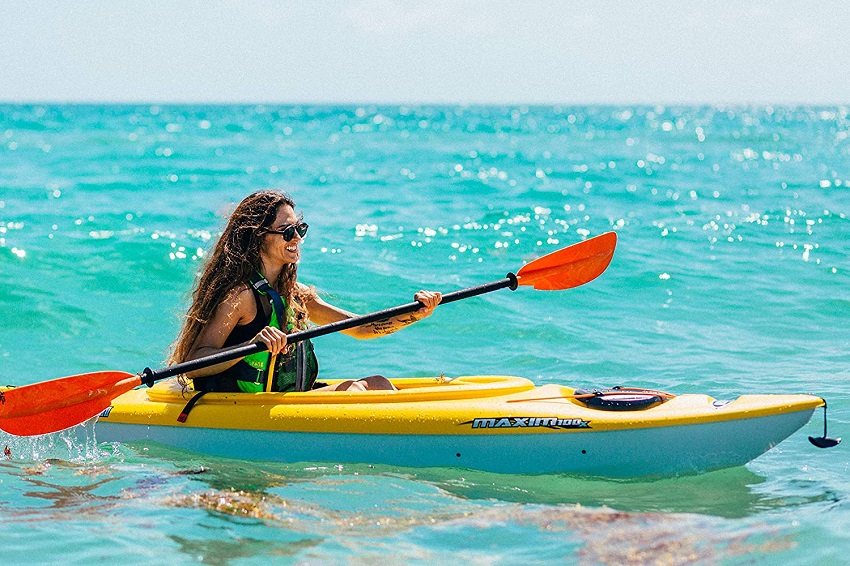
Comfort goes a step further than just the “fit”, though. It includes all those factors I listed above but also takes into account things like:
- The cushioning of the seat
- The lumbar support of the backrest
- The comfort of the foot braces
- Thigh and/or knee pads to brace against
The longer you’re going to spend sitting in your kayak, the more comfort will matter.
Accessories and Extras
Many recreational kayaks (especially the budget-friendly models) will come with pretty much the bare essentials:
- Seat (with cushion and back rest)
- Bungee cords on the deck to lash down objects
- Storage compartment (watertight or not)
Some recreational and fishing kayaks offer more useful features:
- Skegs
- Rudder system (or the compatibility to mount one)
- Drinks holder
- Extra storage space for coolers and tackle boxes
- Paddle keeper
Then, if you’re getting a really high-end kayak, you might get some really cool accessories and extras like:
- Pedal drive (always pricey but well worth it for hands-free fishing)
- Rails and tracks to mount fishing rod holders and other accessories
- Trolling motor mount
Just be aware that the more accessories the kayak includes, the higher the price is likely to be. It definitely could be worth paying more for a few cool “add-ons”, though!
Price
Price is always a factor to consider, albeit one of lesser importance.
You can find a lot of pretty great-quality budget-friendly kayaks—sturdy, stable, with good performance, though they’ll be light on the accessories. Recreational kayaks can start as low as $200 or $300, and even these budget models are worth considering.
If you want a few more features, or a slightly more reliable fishing kayak, the price rises to the $500 to $800 range.
Premium-quality kayaks with the more “advanced” features (like rudder system, trolling motor compatibility, pedal drive, etc.) will usually start at around $1,000+ and rise as high as $3,000.
For newbies who are just getting into kayaking, it may be a good idea to start off with a more budget-friendly model until you get accustomed to paddling, then upgrade later on when you know exactly what kind of kayak you want to buy.
10-Foot Kayaks FAQs
A 10-foot fishing kayak will typically be very stable on flat, calm water, thanks to its high primary stability. 10-foot recreational kayaks may sacrifice primary stability for more secondary stability, especially if they’re designed to be used in coastal waters or fast-moving rivers.
Typically, a 10-foot recreational kayak will have a weight limit lower than 250 lbs, while a 10-foot fishing kayak will have a weight limit of less than 275 lbs.
Fishing, paddling around rivers and lakes, exploring calm coastal waters, traveling around the country to explore different waterways, and overnight camping trips.
A 10-foot kayak should easily accommodate anyone under 6’3” (depending on leg length).
Taller kayakers (like myself at 6’6”) may want to consider a 12-footer with more room to stretch out your legs.


